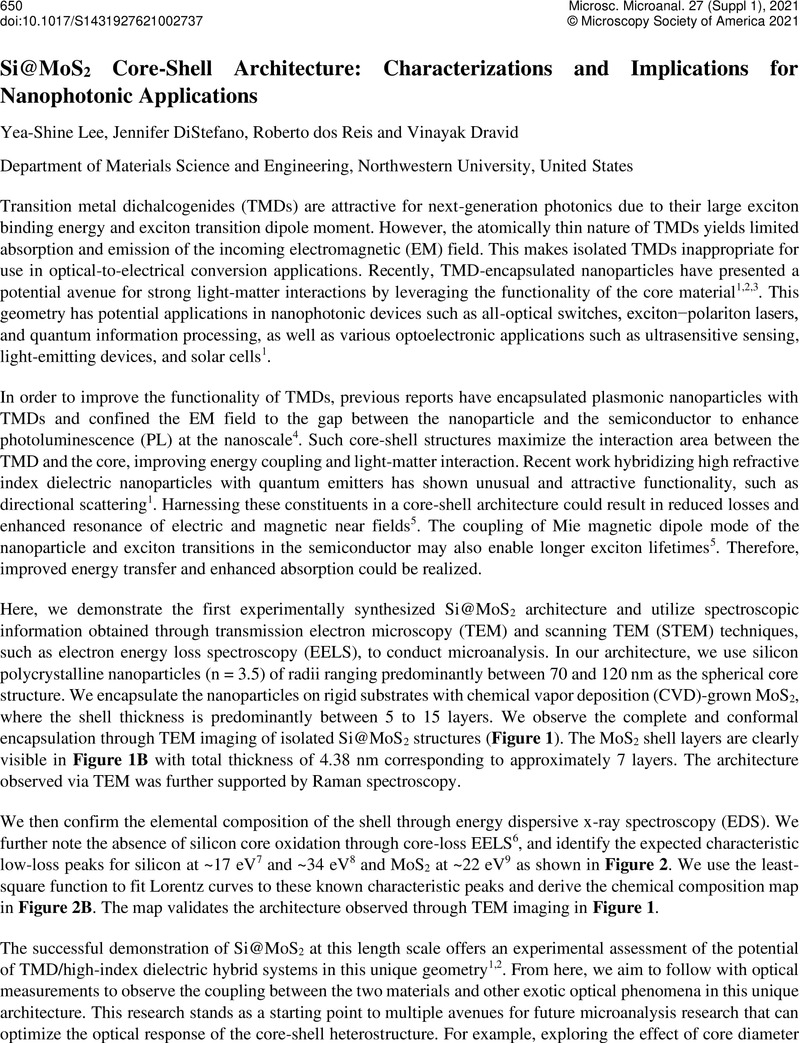No CrossRef data available.
Article contents
Si@MoS2 Core-Shell Architecture: Characterizations and Implications for Nanophotonic Applications
Published online by Cambridge University Press: 30 July 2021
Abstract
An abstract is not available for this content so a preview has been provided. As you have access to this content, a full PDF is available via the ‘Save PDF’ action button.

- Type
- Emerging Low-Dimensional Nanomaterials and Their Heterostructures
- Information
- Copyright
- Copyright © The Author(s), 2021. Published by Cambridge University Press on behalf of the Microscopy Society of America
References
Wang, H. et al. Resonance Coupling in Heterostructures Composed of Silicon Nanosphere and Monolayer WS2: A Magnetic-Dipole-Mediated Energy Transfer Process. ACS Nano 13, 1739–1750 (2019).CrossRefGoogle ScholarPubMed
Lepeshov, S. et al. Tunable Resonance Coupling in Single Si Nanoparticle–Monolayer WS2 Structures. ACS Appl. Mater. Interfaces 8 (2018).Google Scholar
DiStefano, G., et al, J.. Topology of transition metal dichalcogenides: the case of the core–shell architecture. Nanoscale 12, 23897–23919 (2020).CrossRefGoogle ScholarPubMed
Wu, Z.-Q. et al. Gap-Mode Surface-Plasmon-Enhanced Photoluminescence and Photoresponse of MoS2. Advanced Materials 30, (2018).CrossRefGoogle ScholarPubMed
Kuznetsov, A. I., Miroshnichenko, A. E., Brongersma, M. L., Kivshar, Y. S. & Luk'yanchuk, B. Optically resonant dielectric nanostructures. Science 354, (2016).CrossRefGoogle ScholarPubMed
Grunes, L. A., Leapman, R. D., Wilker, C. N., Hoffmann, R. & Kunz, A. B. Oxygen K near-edge fine structure: An electron-energy-loss investigation with comparisons to new theory for selected 3 d Transition-metal oxides. Phys. Rev. B 25, 7157–7173 (1982).CrossRefGoogle Scholar
Eljarrat, A. et al. Retrieving the electronic properties of silicon nanocrystals embedded in a dielectric matrix by low-loss EELS. Nanoscale 6, 14971–14983 (2014).CrossRefGoogle Scholar
Mkhoyan, K. A., Babinec, T., Maccagnano, S. E., Kirkland, E. J. & Silcox, J. Separation of bulk and surface-losses in low-loss EELS measurements in STEM. Ultramicroscopy 107, 345–355 (2007).CrossRefGoogle ScholarPubMed
Forcherio, G. T., Benamara, M. & Roper, D. K. Electron Energy Loss Spectroscopy of Hot Electron Transport between Gold Nanoantennas and Molybdenum Disulfide by Plasmon Excitation. Advanced Optical Materials 5, 1600572 (2017).Google Scholar



